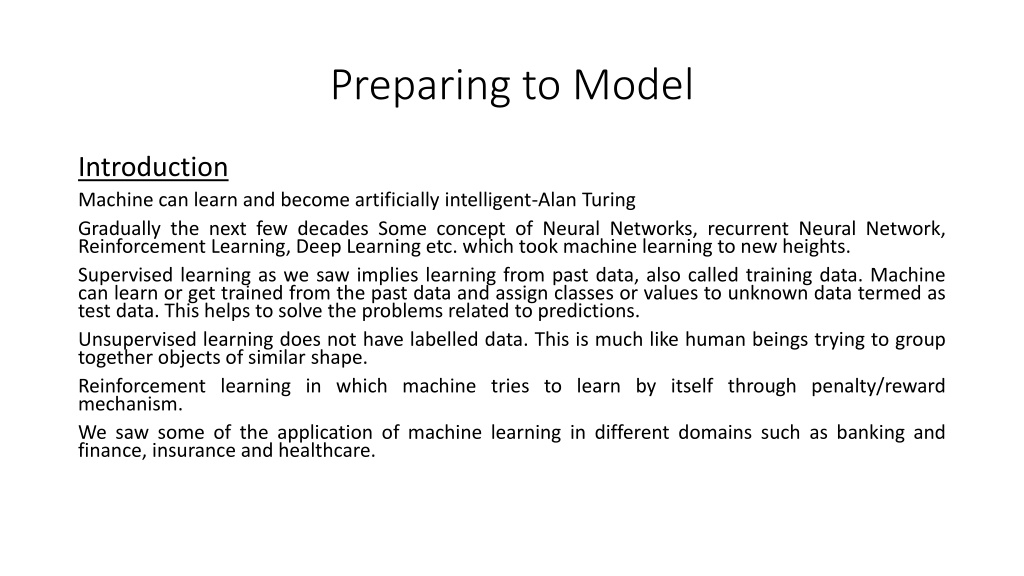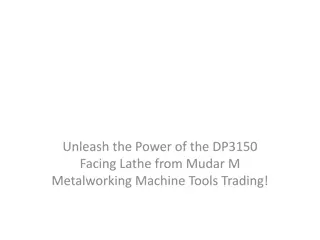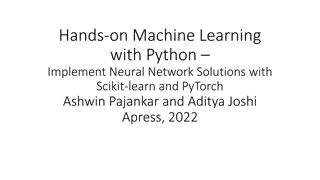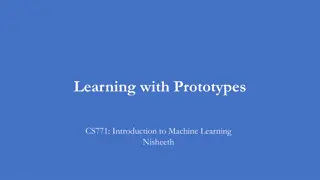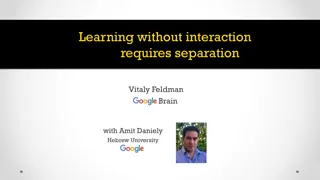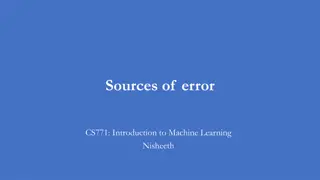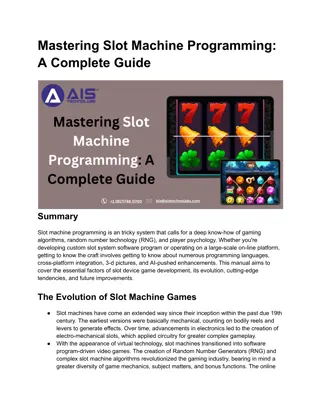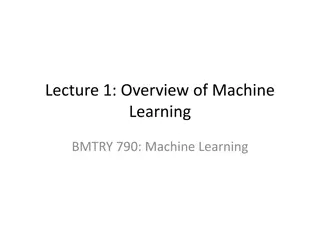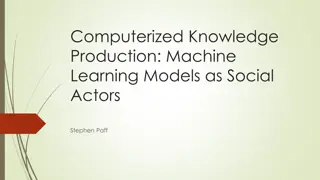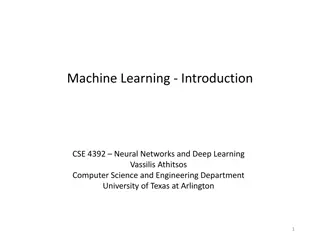Understanding Machine Learning: A Comprehensive Overview
Machine learning has evolved significantly over the decades, driven by concepts like Neural Networks, Reinforcement Learning, and Deep Learning. This technology enables machines to learn from past data to make predictions. Activities in machine learning involve data exploration, preparation, model training, and evaluation. The process includes understanding the types and attributes of data, selecting appropriate models, dividing data into training and test sets, and evaluating model performance. Different types of data in machine learning include qualitative and quantitative data.
Download Presentation

Please find below an Image/Link to download the presentation.
The content on the website is provided AS IS for your information and personal use only. It may not be sold, licensed, or shared on other websites without obtaining consent from the author. Download presentation by click this link. If you encounter any issues during the download, it is possible that the publisher has removed the file from their server.
E N D
Presentation Transcript
Preparing to Model Introduction Machine can learn and become artificially intelligent-Alan Turing Gradually the next few decades Some concept of Neural Networks, recurrent Neural Network, Reinforcement Learning, Deep Learning etc. which took machine learning to new heights. Supervised learning as we saw implies learning from past data, also called training data. Machine can learn or get trained from the past data and assign classes or values to unknown data termed as test data. This helps to solve the problems related to predictions. Unsupervised learning does not have labelled data. This is much like human beings trying to group together objects of similar shape. Reinforcement learning in which machine tries to learn by itself through penalty/reward mechanism. We saw some of the application of machine learning in different domains such as banking and finance, insurance and healthcare.
Machine learning Activities The first step in Machine learning activity starts with data. A thorough review and exploration of the data is needed to understand the type of the data, the quality of the data and relationship between different data elements. -preparation activities done once the input data comes into the machine learning system Understand the type of data in the given input dataset. Explore the data to understand the nature and quality. Explore the relationship. Do the necessary remediation. Apply pre-processing steps as needed
Machine learning Activities. Once the data is prepared for modelling, then the learning task start off The input data is divided into parts- training data and the test data Consider different models or learning algorithms for selection Train the model based on the training data for supervised learning problem and apply to unknown data After the model is trained(for supervised learning), and applied for the input data, the performance of the model is evaluated.
Four step process of Machine learning Detailed process of Machine learning Preparing to model (Step-1) Learning (Step-2) Input data Performance improvement (Step-4) Performance Evaluation (Step-3)
Basic type of Data in machine Learning A dataset is a collection of related information or records. Each row of dataset is called record. Each data set also has multiple attributes. Attributes can also termed as feature, variable, dimension or field. Value of an attribute may vary from record to record
Basic type of Data in machine Learning. Data can be broadly be divided into following two types: 1. Qualitative data 2. Quantitative data Qualitative data: provides information about quality of an object or information which can not be measured. Qualitative data is also called categorical data. 1. Nominal data 2. Ordinal data
Basic type of Data in machine Learning. Nominal data: is one which has no numerical value, but a named value. It is used for assigning named values to attributes. Nominal values can not be quantified. Ex. Of Nominal data are.. -Blood group: A, B,O, AB etc. -Nationality: Indian, American, British etc. -Gender: Male, female, other It is obvious mathematical operations such as addition, subtraction, multiplication etc. can not performed on nominal data. Basic count is possible. So mode(most frequently occurring value) can be identified for nominal data
Basic type of Data in machine Learning. Ordinal data: is assign named values to attributes that arranged in a sequence of increasing or decreasing so that we can say whether a value is better than another value. Examples are -Customer satisfaction: very happy , happy , Unhappy -Grades: A, B, C etc. -Hardness of Metal: very hard , Hard , Soft Like nominal data basic counting is possible for ordinal data. The mode can be identified
Basic type of Data in machine Learning. Quantitative data: relates to information about the quantity of an object-hence can be measured. If we consider the attributes marks it can be measured using scale of measurement. It is also termed as numeric data. There are two types of quantitative data.. 1. Interval data 2. Ratio data Interval data: is numeric data for which not only the order is known, but exact difference between value is also known. Ex.-date, time Ratio data: represent numeric data for which exact value can be measured. Absolute zero is available for ratio data. Ex.-height, age weight, salary..
Training a Model(For Supervised Learning) Holdout Method
Training a Model(For Supervised Learning) K-fold Cross-Validation Method: A special variant of holdout method, called repeated holdout , is some times employed to ensure the randomness of the composed data sets. In repeated holdout, several random holdouts are used to measure the model performance. In the end the average of all performance is taken. This process of repeated holdout is the basis of k-fold cross-validation technique. In this the data is divided into k-completely distinct or non-overlapping random partitions called folds. There are two approaches which are popular - 10-fold cross-validation - Leave-one-out cross-validation
Training a Model(For Supervised Learning) K-fold Cross Validation
Training a Model(For Supervised Learning) Bootstrap Sampling: Bootstrap sampling or simply bootstrapping is a popular way to identify training and test data set. It uses the technique of Simple Random Sampling with replacement(SRSWR), which is a well-known technique in sampling theory for drawing random sample Bootstrapping randomly picks data instances from the input data set with the possibility of the same data instance to picked multiple times
Training a Model(For Supervised Learning) Bootstrap Sampling
Model Representation and Interpretability Underfitting Overfitting Bias Variance
